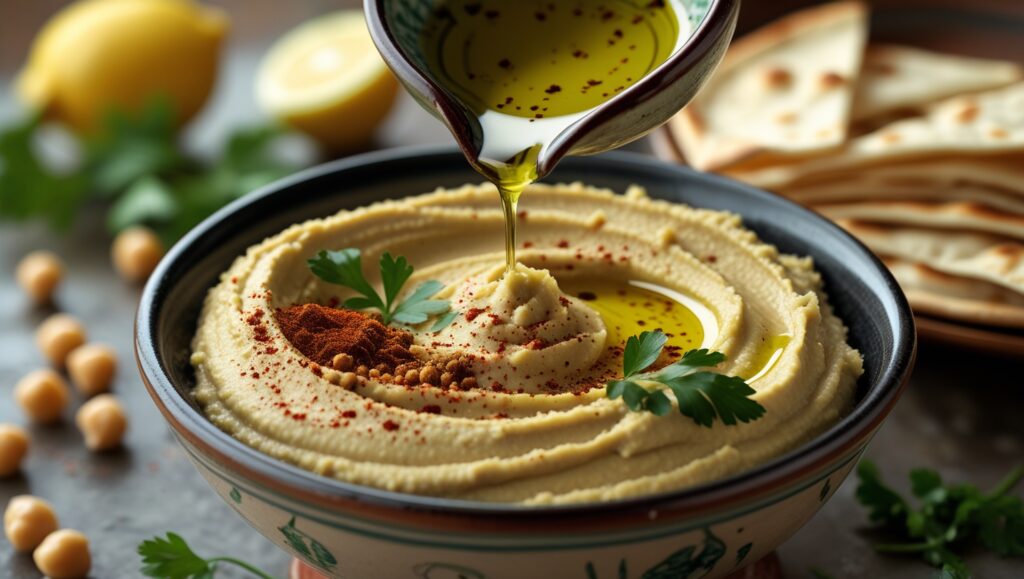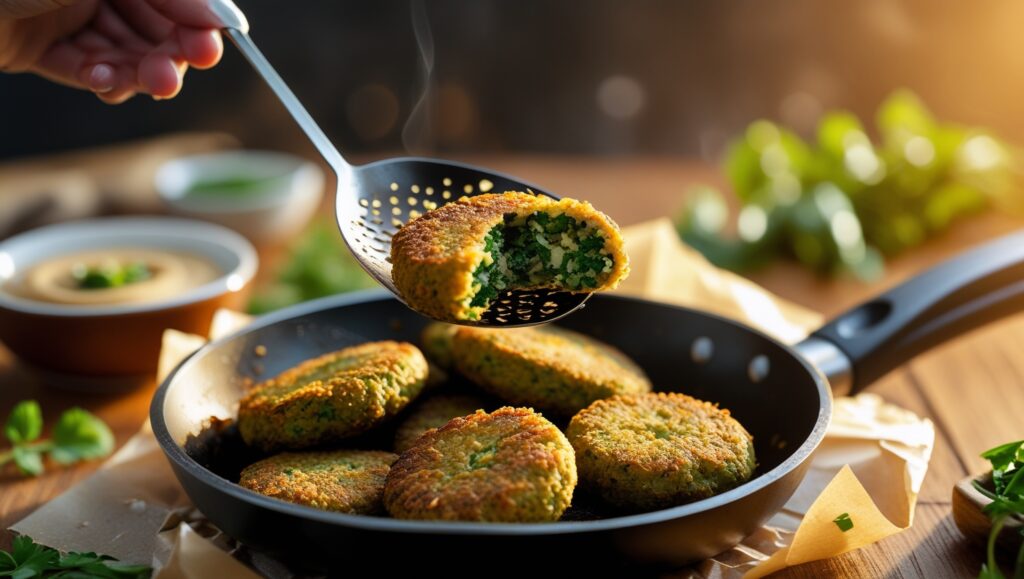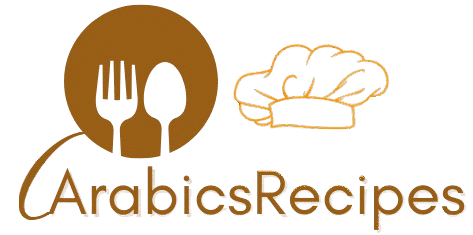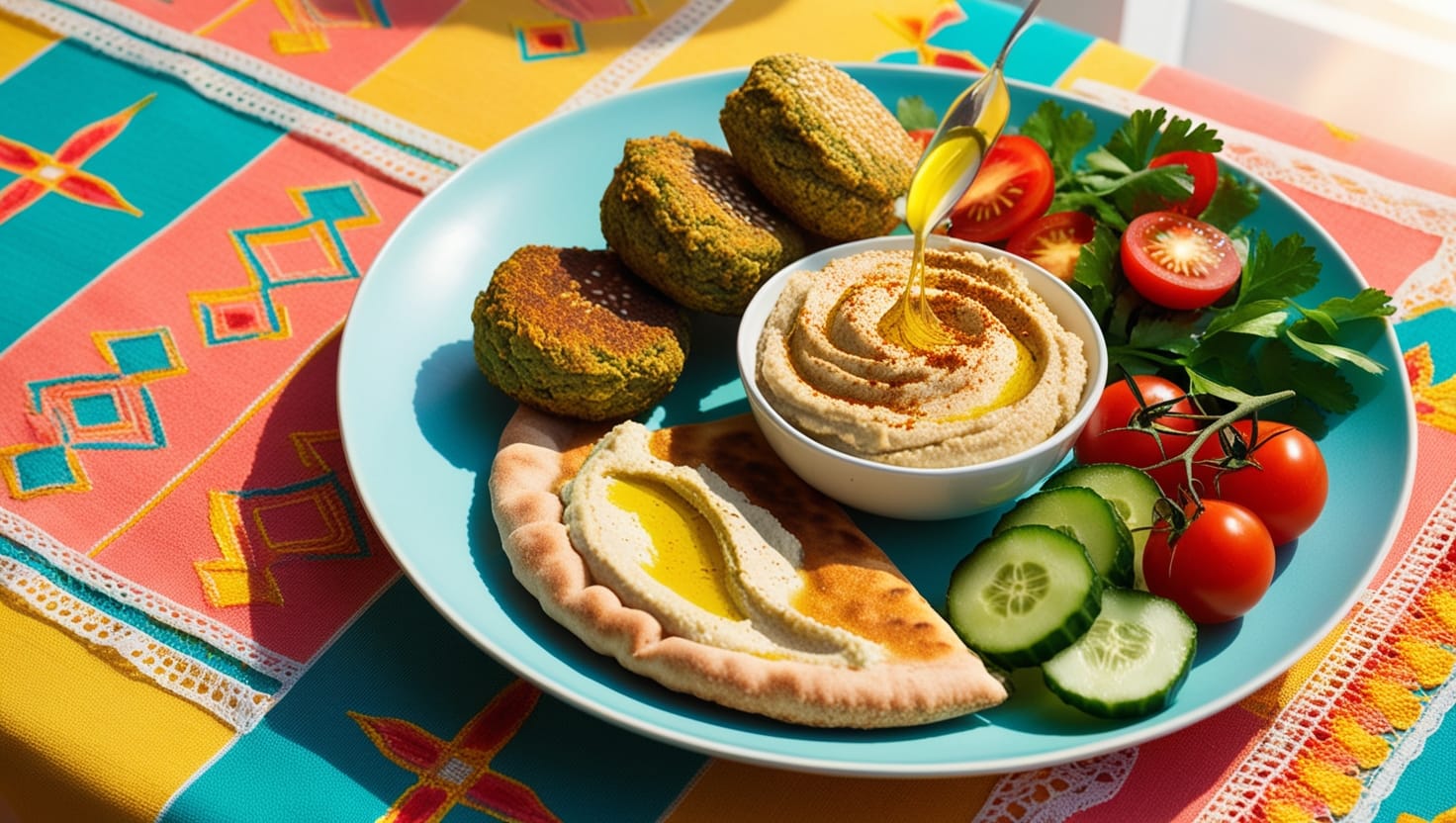A traditional Arabic breakfast is more than just a meal—it’s a cultural experience that brings people together over flavorful, wholesome food. If you’re looking for a nutritious and satisfying way to start your morning, this Hummus and Falafel Plate is the perfect choice. Featuring creamy hummus, crispy falafel, and warm pita bread, this classic Middle Eastern dish is packed with protein and fresh ingredients.
In this article, we’ll explore everything you need to know about making the perfect hummus and falafel plate. From authentic recipes to step-by-step cooking instructions, you’ll learn how to create a traditional Arabic breakfast at home. Whether you’re preparing a weekend brunch or looking for a healthy plant-based meal, this guide will help you master hummus, falafel, and their perfect accompaniments.
Let’s dive in and discover how to make the ultimate Hummus and Falafel Plate!
Introduction to a Traditional Arabic Breakfast
What Is a Traditional Arabic Breakfast?
In many Arabic households, breakfast is a feast of flavors, colors, and textures. Unlike Western breakfasts, which often feature eggs, toast, and coffee, an Arabic breakfast revolves around mezze-style dishes. These include an array of small plates, freshly baked bread, cheeses, olives, vegetables, and dips.
At the heart of this breakfast spread is the hummus and falafel plate, a combination of smooth, garlicky hummus and crispy, golden-brown falafel, served with warm pita, pickles, and tahini sauce.
Why Hummus and Falafel Are Breakfast Staples
So, why do so many people love hummus and falafel for breakfast? Well, it’s all about nutrition, taste, and tradition.
1) Protein-packed and filling – Both hummus and falafel are made from chickpeas, which are high in protein and fiber, keeping you full for hours.
2) Balanced flavors – The combination of creamy hummus, crunchy falafel, and tangy pickles creates an irresistible balance of textures and flavors.
3) Perfect for sharing – Arabic breakfasts are meant to be enjoyed with family and friends, making them a social occasion.
The Cultural Significance of Mezze-Style Breakfasts
The mezze-style breakfast is more than just food—it’s a reflection of Middle Eastern hospitality. Meals are served family-style, encouraging conversation and a sense of community. Hummus and falafel are often homemade, using recipes that have been passed down through generations.
This breakfast also celebrates fresh, wholesome ingredients. From earthy chickpeas to aromatic spices like cumin and coriander, every bite tells a story of tradition and flavor.
Up next, we’ll explore the essential ingredients you need to make the perfect hummus and falafel at home! 🥙
Essential Ingredients for Hummus and Falafel
Authentic Ingredients for the Perfect Hummus
To make authentic, creamy hummus, you’ll need a few simple yet essential ingredients. Each plays a key role in achieving the right texture and taste.
- Chickpeas (Garbanzo Beans) – The base of hummus, providing protein and creaminess.
- Tahini (Sesame Paste) – Adds a nutty, smooth texture. Opt for high-quality tahini for the best flavor.
- Olive Oil – A drizzle of extra virgin olive oil enhances the richness.
- Lemon Juice – Freshly squeezed lemon juice brings a bright, tangy balance.
- Garlic – Essential for that classic Middle Eastern aroma and depth.
- Salt & Cumin – Enhances flavor while adding a slight earthiness.
- Cold Water – Helps create a fluffier, smoother hummus when blended.
Key Spices and Herbs That Make Falafel Flavorful
The secret to delicious falafel is the right blend of spices and herbs. These ingredients give falafel its signature bold and aromatic flavor.
- Chickpeas (Soaked, Not Canned!) – Using dried chickpeas soaked overnight ensures the best texture.
- Onion & Garlic – Adds depth and a mild sweetness.
- Fresh Herbs (Cilantro & Parsley) – These give falafel its vibrant green color and fresh taste.
- Cumin & Coriander – Provides a warm, slightly citrusy flavor.
- Baking Soda – A pinch helps keep falafel light and crispy.
Both hummus and falafel rely on fresh, high-quality ingredients. Now, let’s move on to the step-by-step guide for making the perfect hummus!

Step-by-Step Guide to Making Homemade Hummus
Traditional Hummus Recipe – Smooth, Creamy, and Flavorful
Follow this easy, authentic hummus recipe to achieve the silkiest, most flavorful dip at home.
Ingredients:
- 1 ½ cups dried chickpeas (or 1 can, drained & rinsed)
- ½ cup tahini
- ¼ cup fresh lemon juice
- 2 cloves garlic
- ¼ cup extra virgin olive oil
- ½ teaspoon cumin
- Salt to taste
- Cold water, as needed
Instructions:
1️⃣ Soak the chickpeas overnight, then boil until tender. If using canned chickpeas, rinse well.
2️⃣ Peel the chickpeas (optional but makes hummus smoother).
3️⃣ Blend the tahini, lemon juice, and garlic in a food processor until creamy.
4️⃣ Add chickpeas, cumin, and salt, blending while slowly drizzling in olive oil.
5️⃣ Pour in cold water, 1 tablespoon at a time, to achieve the desired creaminess.
6️⃣ Taste and adjust seasoning as needed.
Pro Tip: Let the hummus sit for 30 minutes before serving—it allows the flavors to deepen!
Secret Tips for Achieving the Perfect Texture
- Use warm chickpeas – They blend easier and create a softer texture.
- Blend tahini and lemon juice first – This ensures a fluffier hummus.
- Don’t skip the cold water – It makes the hummus extra smooth.
Variations of Hummus – Spicy, Roasted Red Pepper, and More
Want to mix it up? Try these flavorful hummus variations:
🔥 Spicy Hummus – Add ½ teaspoon cayenne pepper or chili flakes.
🌶 Roasted Red Pepper Hummus – Blend in grilled red bell peppers for a smoky taste.
🥑 Avocado Hummus – Swap some chickpeas for ripe avocado for a creamy twist.
Now that you’ve mastered hummus, let’s move on to making crispy, golden falafel! 🥙
Crafting the Perfect Crispy Falafel
Classic Falafel Recipe – The Right Blend of Ingredients
No hummus and falafel plate is complete without crispy, golden falafel. This beloved Middle Eastern dish is packed with aromatic spices, fresh herbs, and protein-rich chickpeas, making it the perfect companion to creamy hummus.
Ingredients:
- 1 ½ cups dried chickpeas (soaked overnight, not canned!)
- ½ cup fresh parsley, chopped
- ½ cup fresh cilantro, chopped
- ½ small onion, finely diced
- 2 cloves garlic, minced
- 1 teaspoon cumin
- 1 teaspoon coriander
- ½ teaspoon baking soda
- Salt and black pepper, to taste
- 2 tablespoons flour or chickpea flour
- Oil for frying
Instructions:
1️⃣ Soak chickpeas overnight, then drain and pat dry.
2️⃣ Blend chickpeas, herbs, onion, garlic, and spices in a food processor until slightly coarse.
3️⃣ Add flour and baking soda, then mix until the dough holds together. Refrigerate for 30 minutes to firm up.
4️⃣ Shape into small balls or patties, about the size of a walnut.
5️⃣ Fry in hot oil (350°F/175°C) for 3-4 minutes per side until golden brown.
6️⃣ Drain on paper towels and serve warm.
How to Fry vs. Bake for the Best Crispiness
If you prefer a healthier version, you can bake or air-fry falafel instead of deep-frying.
🔥 Frying: Produces crispy, golden falafel with a crunchy shell and soft interior.
♨ Baking: Bake at 400°F (200°C) for 20-25 minutes, flipping halfway for an even crisp.
💨 Air-frying: Cook at 375°F (190°C) for 12-15 minutes, shaking the basket halfway through.
Common Mistakes to Avoid When Making Falafel
- Using canned chickpeas – They’re too soft, leading to mushy falafel. Always use dried, soaked chickpeas!
- Skipping the chilling step – Refrigerating the dough helps bind the mixture, preventing crumbling.
- Over-blending the mixture – Falafel should have a slightly coarse texture, not a smooth paste.
Now that you’ve mastered crispy falafel, let’s talk about the best side dishes and accompaniments to complete Start Your Day Right: Hummus and Falafel Plate – A Traditional Arabic Breakfast Recipe!
Traditional Side Dishes and Accompaniments
Serving Hummus and Falafel with Fresh Pita Bread
A warm, fluffy pita is the perfect vessel for scooping hummus or making a falafel sandwich. Ideally, freshly baked Arabic bread or whole wheat pita enhances the flavors of your dish.
🥖 Homemade pita – Soft, chewy, and best served warm.
🍞 Flatbread (Laffa or Saj) – A thin, chewy alternative often used in wraps.
🥯 Gluten-free pita – Made from chickpea or almond flour for a healthier option.
Pickles, Olives, and Fresh Vegetables as Classic Add-Ons
A true mezze-style breakfast isn’t complete without an assortment of tangy and crunchy accompaniments. These sides enhance the flavors and add texture to every bite:
- Pickled turnips and cucumbers – Their tanginess balances the earthy falafel and creamy hummus.
- Kalamata or green olives – Briny and rich, adding depth to the plate.
- Fresh veggies (tomatoes, cucumbers, radishes, and lettuce) – Adds crunch and freshness.
Yogurt-Based Sauces and Tahini Drizzles for Extra Flavor
Want to take your hummus and falafel plate to the next level? Drizzle a flavorful sauce over the top for added richness.
🥛 Garlic Yogurt Sauce – A creamy, cooling dip made with Greek yogurt, garlic, lemon, and mint.
🌿 Tahini Sauce – A nutty, slightly bitter sauce made from tahini, lemon, garlic, and water.
🍋 Zesty Lemon Dressing – A fresh, citrusy dressing that ties all the elements together.
Now that you have all the perfect side dishes, it’s time to assemble the ultimate hummus and falafel plate in our next section!
For more Arabic-inspired breakfast ideas, check out this Balaleet – A Sweet and Savory Arabic Breakfast Delight!

How to Assemble the Ultimate Hummus and Falafel Plate
Plating Techniques for a Beautiful Mezze Spread
Presentation is just as important as flavor when preparing Start Your Day Right: Hummus and Falafel Plate – A Traditional Arabic Breakfast Recipe. A well-plated dish not only looks inviting but also enhances the dining experience.
Follow these simple plating techniques for an eye-catching mezze spread:
1️⃣ Use a large serving platter – This allows you to arrange hummus, falafel, and sides beautifully.
2️⃣ Create a hummus swirl – Spread hummus in a circular motion using the back of a spoon, then drizzle with olive oil and a sprinkle of paprika.
3️⃣ Stack falafel neatly – Pile them in the center or along one side for a visually appealing presentation.
4️⃣ Arrange side dishes around the edges – Fresh vegetables, pickles, and olives add pops of color and texture.
5️⃣ Serve with warm pita – Place sliced pita bread in a basket or on the side for easy scooping.
Balancing Flavors and Textures for the Perfect Bite
A great hummus and falafel plate is all about contrast and balance. Here’s how to achieve it:
- Creamy & Crispy – The smoothness of hummus pairs perfectly with the crunch of falafel.
- Tangy & Savory – Pickles, olives, and lemon add a bright contrast to the earthy flavors.
- Warm & Cool – Warm pita and falafel combined with cool cucumber and yogurt sauce create a refreshing balance.
Now that your plate is assembled, let’s explore the nutritional benefits of this traditional Arabic breakfast!
Nutritional Benefits of a Hummus and Falafel Breakfast
Why Chickpeas Are a Superfood for Breakfast
Both hummus and falafel are made from chickpeas, which are considered a nutritional powerhouse. Here’s why they make Start Your Day Right: Hummus and Falafel Plate – A Traditional Arabic Breakfast Recipe such a healthy choice:
- High in plant-based protein – Keeps you full and supports muscle health.
- Packed with fiber – Aids digestion and promotes gut health.
- Rich in vitamins and minerals – Provides iron, magnesium, and B vitamins for lasting energy.
Health Benefits of Olive Oil, Garlic, and Tahini
Beyond chickpeas, the other key ingredients in hummus and falafel offer numerous health benefits:
🌿 Olive Oil – A great source of healthy fats and antioxidants, supporting heart health.
🧄 Garlic – Contains immune-boosting properties and helps lower inflammation.
🥜 Tahini (Sesame Paste) – High in calcium, protein, and essential minerals, making it a great dairy-free source of nutrients.
How This Breakfast Provides Energy and Sustains You Longer
Unlike sugary breakfast cereals, Start Your Day Right: Hummus and Falafel Plate – A Traditional Arabic Breakfast Recipe keeps you energized for hours thanks to:
- Slow-digesting carbs – Chickpeas provide long-lasting fuel without spikes in blood sugar.
- Healthy fats – Olive oil and tahini help sustain energy levels throughout the day.
- Balanced protein – The combination of chickpeas, herbs, and yogurt-based sauces supports overall well-being.
With this knowledge, you can enjoy a delicious, nutritious breakfast that keeps you satisfied and fueled for the day ahead!
Storage, Meal Prep, and Make-Ahead Tips
How to Store Leftover Hummus and Keep It Fresh
Hummus is best when fresh, but if stored properly, it can last up to a week while maintaining its creamy texture.
- Refrigeration: Store hummus in an airtight container and drizzle a thin layer of olive oil on top to prevent drying.
- Avoid Contamination: Always use a clean spoon when scooping hummus to extend its freshness.
- Reviving Hummus: If your hummus thickens over time, stir in a little cold water or olive oil before serving.
Best Ways to Freeze and Reheat Falafel Without Losing Texture
Falafel freezes beautifully, making it a perfect make-ahead meal for busy mornings.
- Freezing Uncooked Falafel: Shape the mixture into balls and place them on a baking sheet. Freeze until solid, then store in a sealed freezer bag for up to 3 months.
- Freezing Cooked Falafel: Let them cool completely, then store in an airtight container with parchment paper between layers.
- Reheating Falafel:
- Oven: Bake at 375°F (190°C) for 10 minutes until crispy.
- Air Fryer: Heat at 350°F (175°C) for 5-7 minutes.
- Stovetop: Lightly pan-fry with a touch of olive oil.
Time-Saving Hacks for Preparing a Week’s Worth of Breakfast
- Make hummus in advance and store it in small containers for easy grab-and-go servings.
- Pre-soak chickpeas at the beginning of the week for faster falafel prep.
- Bake or air-fry falafel in batches and store them for quick meals throughout the week.
With these storage and meal prep tips, Start Your Day Right: Hummus and Falafel Plate – A Traditional Arabic Breakfast Recipe can be a convenient and delicious breakfast option any day of the week!
FAQs About Hummus and Falafel
Is Hummus and Falafel a Healthy Breakfast Option?
Absolutely! Start Your Day Right: Hummus and Falafel Plate – A Traditional Arabic Breakfast Recipe is packed with plant-based protein, fiber, and healthy fats. Unlike sugary cereals or processed breakfast foods, this dish provides sustained energy and essential nutrients to keep you full longer.
Can I Make Falafel Without Frying It?
Yes! While frying gives falafel its classic crunch, there are healthier alternatives:
- Baking: Place falafel on a greased baking sheet and bake at 400°F (200°C) for 20-25 minutes, flipping halfway.
- Air-Frying: Cook at 375°F (190°C) for 12-15 minutes, shaking the basket halfway through.
Both methods result in crispy, golden falafel with less oil.
What Is the Best Way to Get Smooth Hummus?
To achieve ultra-creamy hummus, follow these tips:
- Use warm chickpeas – They blend more smoothly than cold ones.
- Peel the chickpeas – Removing the skins makes the hummus extra silky.
- Blend tahini and lemon juice first – This step helps emulsify the ingredients for a lighter texture.
What Type of Bread Pairs Best with Hummus and Falafel?
The best bread options for scooping hummus and wrapping falafel include:
🥖 Fresh pita bread – Soft and perfect for dipping.
🥯 Laffa or saj bread – Thin, flexible, and great for wraps.
🥗 Gluten-free flatbread – A great option for those avoiding gluten.
With these expert answers, you’re now ready to enjoy the ultimate hummus and falafel breakfast anytime!


Comments are closed.